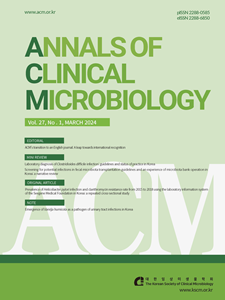Myositis due to Cryptococcus neoformans in a Diabetic Patient
Case report PDF Sang Taek Heo1,3, In-Gyu Bae1,3, Jin Yong Park1, Sun-Joo Kim2,3 Departments of 1Internal Medicine and 2Laboratory Medicine, 3Gyeongsang Institute of Health Sciences, Gyeongsang National University School of Medicine, Jinju, Korea Corresponding to In-Gyu Bae, E-mail: ttezebae@empal.com Ann Clin Microbiol 2009;12(1):1-5.Copyright © Korean Society of Clinical Microbiology. Abstract We report a rare case of cryptococcalmyositis with […]
Misidentification of Candida parapsilosis as Large Platelets in an Automated Blood Analyzer
Case report PDF Do Hoon Kim, Jung Sook Ha, Nam Hee Ryoo, Dong Suk Jeon, Jae Ryong Kim, Young Rok Do, Ki Young Kwon Departments of Laboratory Medicine and Internal Medicine, Keimyung University School of Medicine, Daegu, Korea Corresponding to Nam Hee Ryoo, E-mail: nhryoo@dsmc.or.kr Ann Clin Microbiol 2009;12(3):138-140.Copyright © Korean Society of Clinical Microbiology. […]
A Case of Bacteremia Caused by Rothia dentocariosa
Case report PDF Soon Deok Park1, Young Uh1, Hyeun Gyeo Lee1, Ih Ho Jang1, Kap Jun Yoon1, Mee Kyung Namgoong2 Departments of 1Laboratory Medicine and 2Pediatrics, Yonsei University Wonju College of Medicine, Wonju, Korea Corresponding to Young Uh, E-mail: u931018@yonsei.ac.kr Ann Clin Microbiol 2009;12(3):133-137.Copyright © Korean Society of Clinical Microbiology. Abstract Rothia dentocariosa, a pleomorphic gram-positive branching bacillus, […]
A Case of Brain Abscess due to Parvimonas micra
Case report PDF Ohgun Kwon1, Young Uh1, Ih Ho Jang1, Hyeun Gyeo Lee1, Kap Jun Yoon1, Hyo Youl Kim2, Yong Pyo Han3 Departments of 1Laboratory Medicine, 2Infectious Diseases and 3Neurosurgery, Yonsei University Wonju College of Medicine, Wonju, Korea Corresponding to Young Uh, E-mail: u931018@yonsei.ac.kr Ann Clin Microbiol 2009;12(3):129-132.Copyright © Korean Society of Clinical Microbiology. Abstract Parvimonas micra is a […]
Evaluation of VITEK-2 Antifungal Susceptibility Test (AST-YS01) for Candida Species Isolates in Korea
Original article PDF Da-Woon Kim, Jong Hee Shin, Seung Jung Kee, Soo-Hyun Kim, Myung Geun Shin, Soon Pal Suh, Dong Wook Ryang Department of Laboratory Medicine, Chonnam National University Medical School, Gwangju, Korea Corresponding to Jong Hee Shin, E-mail: shinjh@chonnam.ac.kr Ann Clin Microbiol 2009;12(3):122-128.Copyright © Korean Society of Clinical Microbiology. Abstract Background: VITEK-2 yeast susceptibility […]
Evaluation of OraQuick Advance Rapid HIV-1/2 Antibody Test as a Screening Test for HIV Infection
Original article PDF Tae Youn Choi1, Young Ik Seo1, Tae Hyong Kim2, Jeong Won Shin1, Rojin Park1 Departments of 1Laboratory Medicine and 2Internal Medicine, Soonchunhyang University Hospital, Seoul, Korea Corresponding to Tae Youn Choi, E-mail: choity@hosp.sch.ac.kr Ann Clin Microbiol 2009;12(3):116-121.Copyright © Korean Society of Clinical Microbiology. Abstract Background: For the diagnosis of HIV infection, enzyme immunoassay (EIA) […]
Detection of Respiratory Viruses in Children by Multiplex Reverse Transcriptase PCR, Direct Immunofluorescence Assay, and Shell Vial Culture
Original article PDF Kui Hyun Yoon1, Ji Hyun Cho2 1Department of Laboratory Medicine, Wonkwang University Sanbon Hospital, Gunpo, 2Department of Laboratory Medicine, College of Medicine, Wonkwang University, Iksan, Korea Corresponding to Ji Hyun Cho, E-mail: cjh@wonkwang.ac.kr Ann Clin Microbiol 2009;12(3):110-115.Copyright © Korean Society of Clinical Microbiology. Abstract Background: Direct immunofluorescence assay (DFA) and shell vial culture […]
Metallo-β-lactamase Producing Gram-negative Bacilli
Review article PDF Dongeun Yong Department of Laboratory Medicine and Research Institute of Bacterial Resistance, Yonsei University College of Medicine, Seoul, Korea Corresponding to Dongeun Yong, E-mail: deyong@yuhs.ac Ann Clin Microbiol 2009;12(3):103-109.Copyright © Korean Society of Clinical Microbiology. Abstract Among gram-negative bacteria, rate of antibiotic resistance has been increasing. As a result, carbapenem is now […]
Central Venous Catheter-Related Microbacterium Bacteremia Identified by 16S ribosomal RNA Gene Sequencing
Case report PDF Chang-Jin Moon, Jong-Hee Shin, Eun-Sun Jeong, Seung-Jung Kee, Soo-Hyun Kim, Myung-Geun Shin, Soon-Pal Suh, Dong-Wook Ryang Department of Laboratory Medicine, Chonnam National University Medical School, Gwangju, Korea Corresponding to Jong-Hee Shin, E-mail: shinjh@chonnam.ac.kr Ann Clin Microbiol 2009;12(2):97-101.Copyright © Korean Society of Clinical Microbiology. Abstract We describe here a case of central venous […]
A Case of Streptococcus salivarius Meningitis in a Patient with Cerebrospinal Fluid Rhinorrhea after Skull Base Fracture
Case report PDF Kyeong Seob Shin1, Dong Ik Shin2, Woo Sub Shim3, Byeong Cheol Rim4, Il Hun Bae5, Seung Young Lee5, Dong Hee Ryu6, Eun Jung Kim7, Bo Ra Son1 Departments of 1Laboratory Medicine, 2Neurology, 3Otorhinolaryngology-Head and Neck Surgery, 4Neurosurgery, 5Radiology and 6Surgery, Chungbuk National University College of Medicine, 7Department of Pathology, Chungbuk National University Hospital, Cheongju, Korea Corresponding to Kyeong Seob […]
